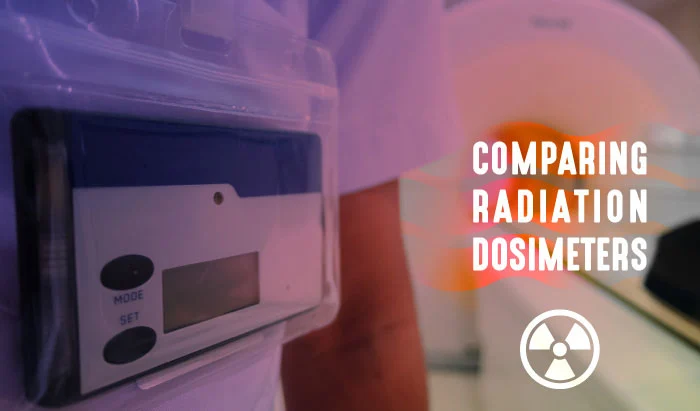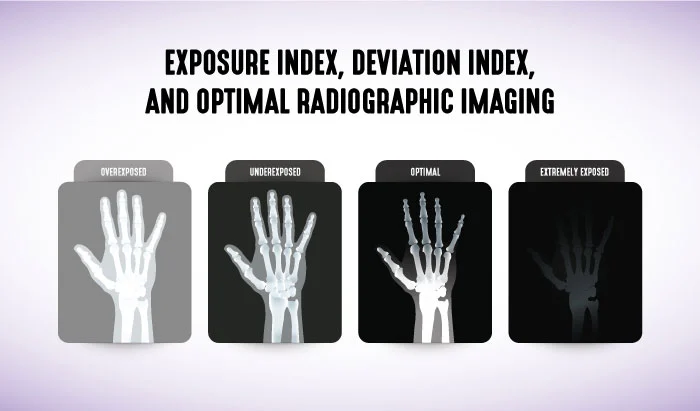Comparing Radiation Dosimeters

Comparing Radiation Dosimeters: OSL, Personnel, tld dosimeter and pocket ionization chamber


The primary source of a radiologic technologist’s radiation exposure comes from scatter radiation emanating from patients. In order to keep the rad techs’ occupational dose exposure levels lower than the annual effective dose (EqD) of 50 mSv (5 rem), the levels must be monitored. And choosing the proper radiation dosimeter is essential. There are many radiation dosimeters used today, such as the thermal luminescent dosimeter (TLD), the pocket ionization chamber dosimeter, the optically stimulated luminescent dosimeter (OSL dosimeter), and the most recently developed personnel dosimeter, the direct reading digital ionization dosimeters. This article will describe each type of dosimeter and how they work.
Radiation Dosimeters: Thermal Luminescent Dosimeter (TLD)

The thermal luminescent dosimeter (TLD) is a light free device, usually containing a crystalline form of lithium fluoride that functions as the sensing material of the TLD. Ionizing radiation causes some of the electrons in the crystalline lattice structure of the lithium fluoride molecule to absorb energy, exciting them to higher energy levels or bands. The electrons can return to their original or normal state with the emission of energy in the form of visible light. The analyzer then measures the amount of ionizing radiation that the TLD has been exposed and develops a glow curve representing the exposure received by the individual TLD. This device measures exposures as low as 1.3 x 10-6 C/kg (5 mR) accurately and may be used for up to three months. TLDs may only be read once because the read out process destroys the stored information.
Radiation Dosimeters: Pocket Ionization Chamber Dosimeter

image from NDT Resource Center
The pocket ionization chamber, which resembles an ordinary fountain pen, is considered to be the most sensitive type of personnel dosimeter. There are two types of pocket dosimeters: self- reading and non self-reading. The pocket ionization chamber contains two and the other negatively charged electrodes, one of which is positively charged. When exposed to gamma and x-radiation, the air surrounding the pre-charged central or positive electrode becomes ionized. Subsequently, the negative ions in the air are attracted to the positively charged central electrode, neutralizing its charge. This has the effect of discharging the mechanism in direct proportion to the amount of radiation that the device was exposed to. These devices are expensive, costing as much as $150 per unit, and if not read out every day, may give an inaccurate reading. The use of this type of radiation dosimeter is uncommon in diagnostic imaging.
Radiation Dosimeters: Optically Stimulated Luminescence (OSL) Dosimeter

The second most sensitive between radiation dosimeters is the optically stimulated luminescence dosimeter or OSL dosimeter. This is the most common type of personnel dosimeter used in the monitoring of occupational radiation exposure in diagnostic radiology today. This type of dosimeter is light-weight, durable, and easy to carry. It contains an aluminum oxide detector and is read out by using a laser light at selected frequencies. When the laser light is incident on the sensing material, it becomes luminescent in proportion to the amount of radiation exposure it received. An OSL dosimeter can be worn for up to one year, but they are usually worn for only 1-3 months before being read out. These devices provide an accurate reading as low as 10 µSv for X-ray and gamma ray photons with energies ranging from 5 keV to greater than 40 MeV.
Radiation Dosimeters: Digital Ionization Personnel Dosimeters

Compact professional personnel digital ionization dosimeters have been developed and designed to monitor and measure the personal dose equivalent rate from both gamma and a range of 20 keV to 10 MeV. This type of radiation dosimeter, which is small in size and similar in appearance to a flash drive, provides immediate measurement of radiation exposure. It allows for manual or automatic recording up to 4000 events of dose rate change, acute dose levels, and the time and levels when present threshold values were exceeded. The dosimeter communicates with a PC via a USB channel with simultaneous battery charging. Also, it contains a Personal Dose Tracker software that enables analysis of dose readings and report generation. Some of these reports include, but are not limited to, a radiation exposure summary, a history detail report, and a report on who has not read this device. Some contain a GPS, a global positioning system, or microchip that also adds data concerning the location of exposure events.
Radiation Dosimeters: Why, When, Where They Are Needed

A radiation dosimeter is required when a radiation worker is likely to risk receiving 10% or more of the annual occupational EfD limit (50 mSv (5 rem)) in any single year as a result of work-related activities. It is important to note that these devices do not protect you from radiation exposure. Whether you use a TLD dosimeter, a pocket ionization chamber dosimeter, and osl dosimeter, or a digital ionization dosimeter, it is important that you wear the device in the same place consistently. And if you are wearing a lead apron, you should wear your dosimeter at collar level outside the lead apron. Reports generated from your personnel dosimeter should be reviewed by both you and the administering personnel, in order to ensure that there has been no radiation exposure over a period of time. You should initial these reports and keep them as a record of lifetime radiation exposure.
References
Personal radiation dosimeter direct-reading digital dosimeters. (n.d.). Retrieved January 23, 2021
Alice, S. S. (2018). Radiation protection: In medical radiography (8th ed.). St Louis, Missouri: Elsevier.


